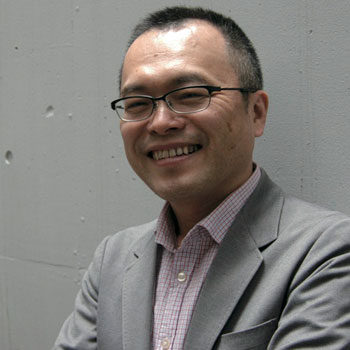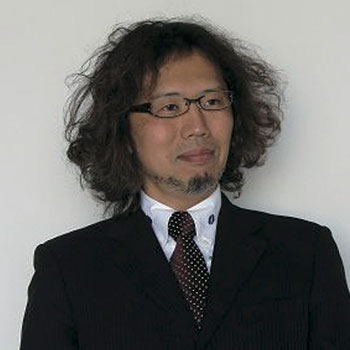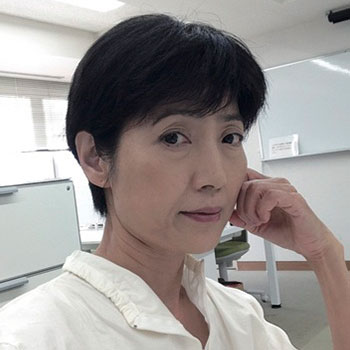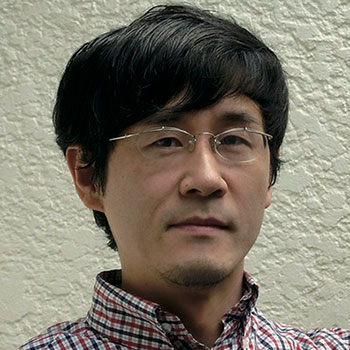In animation, connecting the images produced by each frame on screen is quite simple as far as technique is concerned, but the choices for creating the form of an animation are extensive. Two-dimensional pictures and figures are created by frame from materials slightly alienated from reality, and transcending the physical properties of the raw material shown, “things” are transformed into “happenings,” and the world described in metaphor. Animation is a device that transforms the metaphysical realm into one physically visualized. This is not only some imagined fabrication, but may also include the recording of unintended emotions, possibly irradiating the inside more vividly and, in a sense, acting as a terrible, powerful endoscope. What must be remembered is that animation may just as easily exhibit a terrible power to project naked desires or frivolous thoughts, as express some profound inner psychology.
Armed with an understanding of the characteristics of animation, students will discover their own original aesthetics through the creative process.
In animation, connecting the images produced by each frame on screen is quite simple as far as technique is concerned, but the choices for creating the form of an animation are extensive. Two-dimensional pictures and figures are created by frame from materials slightly alienated from reality, and transcending the physical properties of the raw material shown, “things” are transformed into “happenings,” and the world described in metaphor. Animation is a device that transforms the metaphysical realm into one physically visualized. This is not only some imagined fabrication, but may also include the recording of unintended emotions, possibly irradiating the inside more vividly and, in a sense, acting as a terrible, powerful endoscope. What must be remembered is that animation may just as easily exhibit a terrible power to project naked desires or frivolous thoughts, as express some profound inner psychology.
Armed with an understanding of the characteristics of animation, students will discover their own original aesthetics through the creative process.
Koji Yamamura, Professor
Born in 1964. During the 1990s, He was making films for children, "Pacusi", "Bavel's Book" and so on. Nominated for an Oscar for Best Animated Short, "Mt. Head" (2002) had 6 grand prizes and selected 100 Films for a Century of Animation. "Franz Kafka’ s A Country Doctor" (2007) had 6 grand prizes, his films got awarded more than 100 prizes. He has been selected as the 2 place at 25 top short animated films directors over the last 25 years in 2021.
He is also active as a picture book author for "Viva Vegetables (Oyaoya Oyasai)", "Parade" and so on.
He was awarded Kawakita Prize and Education Award for Fine Arts in Japan and received the Medal with Purple Ribbon in 2019.
A member of the Academy of Motion Picture Arts and Sciences, a sub-chairman of the Japan Animation Association and a member of the board of directors of ASIFA.
Model Animation Course
“Model” in this instance is a technical categorization referring to the likes of stop-motion animation and indicating three-dimensional objects (3D) as opposed to two-dimensional drawings (2D).
Essentially, for students aiming to create solid figures or puppet animation, this course offers a highly effective setting for learning, because certain specialized techniques must be mastered for a full command of modeling and filming.
In the last few years, arts universities across the world have produced myriad examples of what may confidently be referred to as the next generation of stop-motion animation: combining cut-outs, half-solid actual scenery and persons, the texture of unique materials, and drawing.
Catering flexibly to what might be termed a new stage of expression, in which techniques are borderless, is perhaps the defining characteristic of this domain.
“Model” in this instance is a technical categorization referring to the likes of stop-motion animation and indicating three-dimensional objects (3D) as opposed to two-dimensional drawings (2D).
Essentially, for students aiming to create solid figures or puppet animation, this course offers a highly effective setting for learning, because certain specialized techniques must be mastered for a full command of modeling and filming.
In the last few years, arts universities across the world have produced myriad examples of what may confidently be referred to as the next generation of stop-motion animation: combining cut-outs, half-solid actual scenery and persons, the texture of unique materials, and drawing.
Catering flexibly to what might be termed a new stage of expression, in which techniques are borderless, is perhaps the defining characteristic of this domain.
Yuichi Ito, Professor
Animation director. Born in 1962. After working with the visual effects studio Shirogumi, and in computer graphics production, in 1998 he launched the animation studio I.TOON Ltd. and currently serves as its president. His many projects integrating multiple (mainly 3D) animation techniques include KNYACK!! (NHK Educational TV), broadcast for more than 20 years; Harbor Tale (2011), winner of Best Animated Film at the Zlin Film Festival (Czech Republic); the television commercial for Kao Kyukyutt o, and the animation software Claytown, which he co-supervised. He is on the board of directors of Japan Animation Association, and a member of ASIFA-JAPAN.
Producing Course
When animation is seen as a means of communicating with society, it has infinite capabilities and can be very powerful. Animation is an attractive form of expression, thanks to its ability to be shared across time, space and language, depending on ideas. Examples include the sharing of majestic fantasy worlds in the cinema or on TV, and interfaces that act as guides for secure and safe behavior in daily life.
In the Producing Course, we hope to see students forging strong communication berween producer and audience, facilitated by a focus on designing a plan in order to maximize the capabilities of animation, and realizing that plan, all of which involves the application of new forms of media and technology.
One of the best features of animation is the “story” created out of movement, and I also believe the sustainability of animation depends on the ways we find to convey this narrative quality to the audience.
When animation is seen as a means of communicating with society, it has infinite capabilities and can be very powerful. Animation is an attractive form of expression, thanks to its ability to be shared across time, space and language, depending on ideas. Examples include the sharing of majestic fantasy worlds in the cinema or on TV, and interfaces that act as guides for secure and safe behavior in daily life.
In the Producing Course, we hope to see students forging strong communication berween producer and audience, facilitated by a focus on designing a plan in order to maximize the capabilities of animation, and realizing that plan, all of which involves the application of new forms of media and technology.
One of the best features of animation is the “story” created out of movement, and I also believe the sustainability of animation depends on the ways we find to convey this narrative quality to the audience.
Mitsuko Okamoto, Professor
Former producer for NHK. From 2000, she planned and produced the TV program Digital Stadium, considered a gateway to success for budding film creators, and the event Digital Art Festival (DAF) Tokyo; from 2010, the series 2355 and 0655, both broadcast weekdays on NHK Educational TV, in collaboration with Professor Masahiko Sato of this graduate school; and from 2012, TECHNE: The Visual Workshop for Studying Filmmaking.
Research and Theory Course
Among all kinds of video expressions mixed, the animation that can create all the constituent elements out of nothing has the possibility of infinite expressive means. Recently, the evolution of technology and the emergence of advanced media have expanded the possibilities of its expression. The fact that there can be an infinite method means that we must find our own methodology. When visualizing emotions and scenes beyond languages, it is necessary to find suitable means in order to approach the intended image. While grasping the characteristics of animation and images themselves, they build their own expressive world through the whole space such as sound and time. I would like to find out the way of “world building” through creation.
Among all kinds of video expressions mixed, the animation that can create all the constituent elements out of nothing has the possibility of infinite expressive means. Recently, the evolution of technology and the emergence of advanced media have expanded the possibilities of its expression. The fact that there can be an infinite method means that we must find our own methodology. When visualizing emotions and scenes beyond languages, it is necessary to find suitable means in order to approach the intended image. While grasping the characteristics of animation and images themselves, they build their own expressive world through the whole space such as sound and time. I would like to find out the way of “world building” through creation.
Research and Theory Course
Taruto Fuyama, Professor
Ph.D. Began producing 3DCG animation in the 1990s. Since 2003 he has been developing devices for producing animation and holding interactive exhibitions and workshops at museums both in Japan and abroad. KOMA KOMA, his stop motion animation app, has had over 1,000,000 downloads worldwide. His practical research include the creation of personnel development programs through academic-industry collaborations and the application of animation in the field of mental health. He is a Vice President of the Japan Society for Animation Studies.
Research and Theory Course
Nahomi Maki, Lecturer
Maki began creating animation in the 2000s and earned a PhD in film studies in 2017. She joined this faculty after working in a film production studio in the US and undertaking academic research. She has created 2D and 3DCG animation, and in recent years has expanded her activities into full-dome film, VR production and research. Screenings of her work include the 16th Japan Media Arts Festival, Annecy Animation Film Festival 2009, 11th Fulldome Film Festival (Germany), and SIGGRAPH Asia 2018 VR Showcase.
Specialized Subjects
- Oguchi Takayuki (Animation History)
- Otsuka Eiji (Manga and Film Expression and History)
- Katabuchi Sunao (Manga and Film Expression and History)
- Kishino Yuichi (Animation Sound)
- Takayama Hiroshi (Animation Sound)
- Oguchi Takayuki (Animation History)
- Otsuka Eiji (Manga and Film Expression and History)
- Katabuchi Sunao (Manga and Film Expression and History)
- Kishino Yuichi (Animation Sound)
- Takayama Hiroshi (Animation Sound)
General Subjects
- Kurose Yohei (Contemporary Art)
- Shina Yukari (Manga Studies)
- Miake Ryuta (Theory of Narrative)
- Karen Severns (International Cinema and Cultural History)
- Akira Mizuta Lippit (Film Studies)
- Kurose Yohei (Contemporary Art)
- Shina Yukari (Manga Studies)
- Miake Ryuta (Theory of Narrative)
- Karen Severns (International Cinema and Cultural History)
- Akira Mizuta Lippit (Film Studies)






